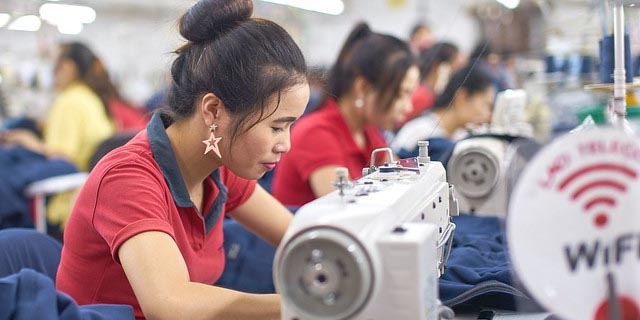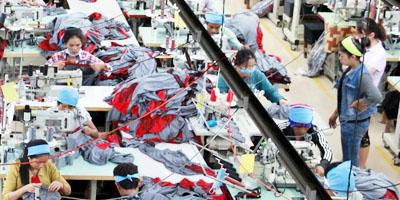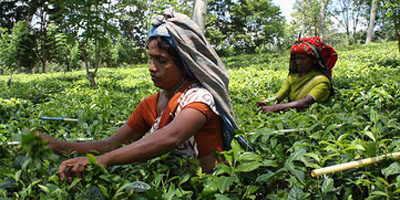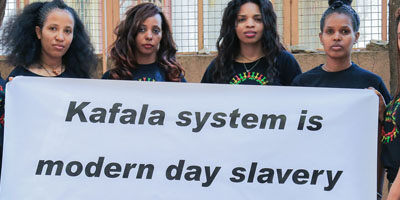Our current fashion mass-producing system is driving poverty, pollution and ultimately climate change says LaRhea Pepper, Managing Director of the Texas based NGO Textile Exchange.
Video – Three experts share insights into fast fashion and its impacts.
La Rhea has an extensive background as an organic cotton producer in Texas. She co-founded the non-profit Organic Exchange in 2002, which changed to Textile Exchange where she has been managing director since 2006.
Textile Exchange focuses on promoting “preferred fibers” that have a positive impact on the environment such as creating biodiversity, reducing desertification, grazing practices and crop practices. Currently they have over 300 brands signed up that have a preferred fiber strategy.
A similar approach has been adopted by the boardsports fashion brand Volcom and its Farm to Yarn program of organic cotton in India. According to Derek Sabori, former vice president of Volcom, producing organic cotton is the new way of fighting against pollution, while ensuring the livelihood of cotton farmers and garment workers in their supply chain by negotiating wages with their partners.
Sabori has worked with Volcom since 1996, becoming its vice-president of global sustainability in 2015. He also co-founded the sustainable fashion brand Underswell in 2015, and has been an instructor in sustainability topics at Orange County College since 2018.
Volcom is a fashion brand based in Costa Mesa, California specializing in boardsports-oriented products. Founded in 1991, it started sustainable production with its Farm to Yarn program in 2006, working with cotton farmers in India to produce organically.
Frank Hoffer, is the executive director of ACT, based in Berlin, Germany. ACT was created in 2016 by global brands and retailers in the garment, textile and footwear sector together with IndustriALL, the global trade union federation representing garment and textile workers. Since then 21 brands signed the Memorandum of Understanding, which is an agreement between brands and IndustriALL on establishing freedom of association, collective bargaining and living wages.
Prior to ACT, he worked for twenty years as a specialist for wages, industrial relations and social dialogue at the International Labour Organisation.
Hoffer says that, apart from producing sustainably, a key factor in ensuring the livelihood of workers along the supply chain is to establish fair wages. The concept of fast fashion only works if wages for farmers and workers in garment factories are kept at an extremely low level.
As a result, undermining fast fashion entails two approaches. One is the approach adopted by ACT, Textile Exchange and Volcom to bring companies and partners together in the industry to negotiate wages and fair labour standards. The traceability of the supply chain has become an important measure to improve workers’ situations. The other is the fostering of sustainability, as Textile Exchange does with its focus on sustainable fibers and organic cotton, and Volcom does with its Farm to Yarn program.

Industry collaboration for higher wages
When I spoke with LaRhea Pepper she said that most of the negative impacts caused by the fast fashion industry are due to unfair prices along the supply chain.
“Let’s talk about a shepherd family in Mongolia. In order to make more money, instead of having twenty goats on a piece of land they put forty, but by putting forty goats on that land they’re overgrazing it,” she said. “They’re contributing to desertification. They can’t maintain their quality of life. Ultimately, they’re losing their culture, and they won’t get a fair price for their product.”
Hoffer shares the same viewpoint. “One of the big issues over the years has been living wages,” he says. “We have come to a point where we think there has to be a sort of cooperation on the level of the industry.”
According to him, if major actors in the industry start collaborating and agree on collective labour standards, other companies will follow, as there would then be a benchmark in the labour market along with consumer expectations. ACT is currently trying to get as many brands as possible to sign up.
He argues that brands that joined such an agreement would enjoy benefits like a certain amount of predictability and stability with the work force. On top of that, consumers would notice the different practices between brands that have joined an agreement and those that have not.
“At some point there is also a thinking in society that we cannot just rely on consumers, but you also have to think whether governments can give a helping hand in that direction. There is a growing awareness in society that something has to change, and this will come through the processes of the industry itself or it will come through initiatives.”
In terms of how higher revenues would translate into higher wages, Hoffer says that this would not happen automatically but rather through collective bargaining between trade unions and manufacturers.
“The challenge is that these kinds of institutions need to be built first,” he says. “That’s why we think that the commitment of international brands and the support of global trade union federations like IndustriALL, which organizes garment workers worldwide, make a difference.”
Volcom’s Farm to Yarn program
Volcom is a company that works together with partners in its supply chain to agree on labour standards.
In 2006 Volcom started the Farm to Yarn program in India with its partners CottonConnect and Kering. The Organic Cotton Farmer Training Program focuses on 150 farmers in India, training them in cultivating organic cotton. This reduces the polluting effects caused by conventional methods of cultivating cotton. Water consumption is reduced since organic cotton is typically rain-fed or drip-irrigated.
Volcom also considers that transparency along the supply chain is crucial to avoid a disconnection between buyer and seller, and key to establishing a strong relationship between them.
Organic cotton prohibits the use of pesticide and GM seeds making it a healthily produced material. Volcom provided me with research data illustrating the benefits of organic cotton, such as a reduction of CO2 equivalent emissions of 46%, and the a 91% reduction in the consumption of non-rain water. According to Volcom, it does not look any different from conventional cotton, and the fiber quality is the same. The only way it differs from conventional cotton is the way it is grown and the value it provides for farmers.
Volcom is indirectly supporting farmers in India through CottonConnect. The organization put up business training schools for developing the farmers’ business skills.
“Supporting those farming groups in those communities is something special,” Sabori says. “It allowed the Volcom brand to have a human connection all the way through the supply chain. The team has been to India to meet the teams there and see what the results and the impacts are.”
The process of shifting towards organic production is quite slow and can be frustrating for farmers in the first three years. The yield will go down first as the soil will first need to get rid of all the chemicals. “In the end the farmers’ costs and inputs were going down and their profits were going up dramatically. And they are also learning how to better manage the costs,” Sabori said.

Education is key
According to Pepper, the solution for fostering sustainability lies in educating the consumers. It is not enough to only shift to sustainable practices, but consumers also need to be informed about the benefits in order for them to make better purchasing decisions. And that is were Textile Exchange comes in.
“We generate reports, workshops and trainings to provide good information so that consumers can make good decisions about what are the best means and mechanisms for them to make more responsible choices,” she says. “The more we’re able to educate, the more we’re able to change minds and practices.”
This is done by building relationships between the brands and the consumers. “Tchibo in Germany had a whole great story around why they are using this kind of fiber,” Pepper said. “At this point in time we’re working with our brands and retailers and their marketing departments to support their communication with their consumers.”
Volcom adopted the same strategy of informing its customers. Sabori described how it communicated the benefits of organic cotton. “We were also struggling with how to message it to the consumer, to let the consumer know how important, and how much better, organic cotton is. So we thought, what if we could show them the farmer, show them the people behind it. That’s a story that the consumer will like and appreciate.”
What about the price of sustainable goods?
Producing sustainably is more expensive than producing in the manner that fast-fashion does, but is there enough consumer awareness of its value to accept higher prices? According to Hoffer, consumers are definitely price sensitive and those with a limited budget will probably give greater importance to price than to sustainability. Even so, he says, “What we notice is that a growing number of consumers want to be sure that the products they are buying are produced in a sustainable fashion.”
Sabori’s recognizes that the greater expense of organic cotton is an issue. “That was something we struggled with, convincing the customer that it was important to pay more for this T-shirt as opposed to the other.”
According to Pepper there is a cost associated with breaking away from mass production, despite it being a system that causes problems like the overuse of antibiotics, growth regulators and fertilizers that create dead zones in marine areas. “You have to invest. It costs more to produce responsibly than it does this mass produce system that is creating poverty, pollution and driving climate change. Why would you not want to invest in something more responsible and healthier for the planet?”
Will sustainable materials satisfy demand?
Sabori admits that organic cotton is still a very small percentage of the amount of cotton produced around the world. But even if the global production of cotton shifted completely to organic cotton, there is still the issue of meeting the demand for clothes. It takes more time to produce organic cotton compared with conventional cotton.
“All indicators just point to the biggest problem, which is just overconsumption,” he says. In the end, consumers have to change their mindset regarding their behaviour and shift to purchasing what they actually need and what is environmentally-friendly.
Pepper agrees. “It doesn’t really matter what you’re making. Maybe instead of buying five shirts, buy one high quality shirt. You, as a consumer, have got to decide what you’re going to invest in. Are going to continue to contribute to poverty and pollution? Your choice.”
Milena Calcagni
“A Swiss national, I am a graduate in European Studies and English Literature at the University of Fribourg in Switzerland. I also obtained my bachelor’s degree in English Literature from the same institution. I have a keen interest in matters of human rights issues and how to solve them. This led me to my decision to undertake an internship at SJC where I write articles for the Upstream Journal.”




